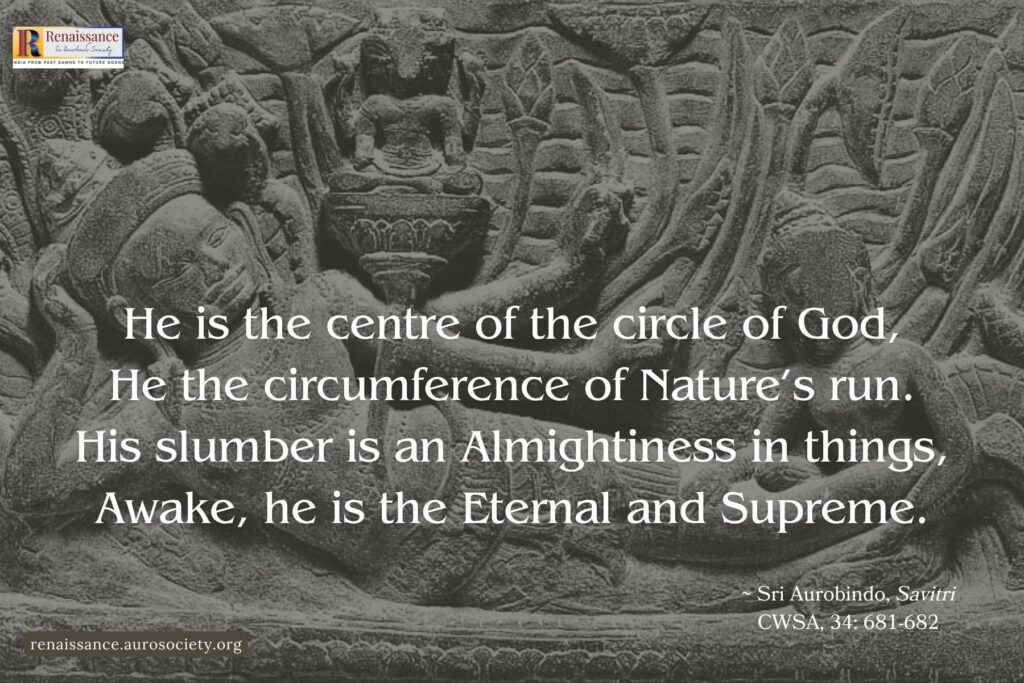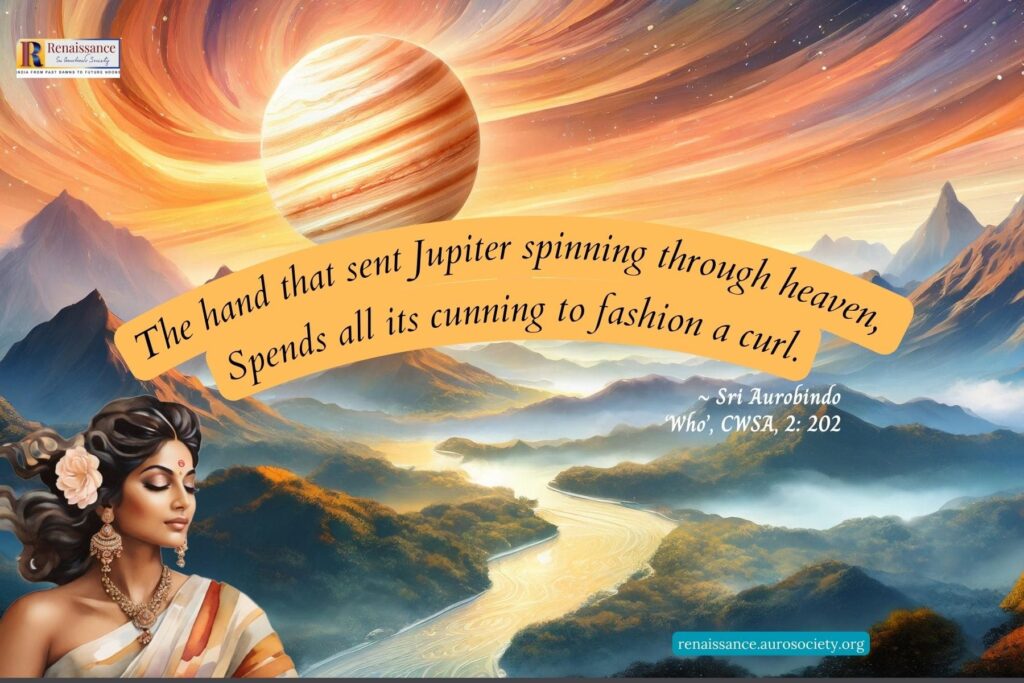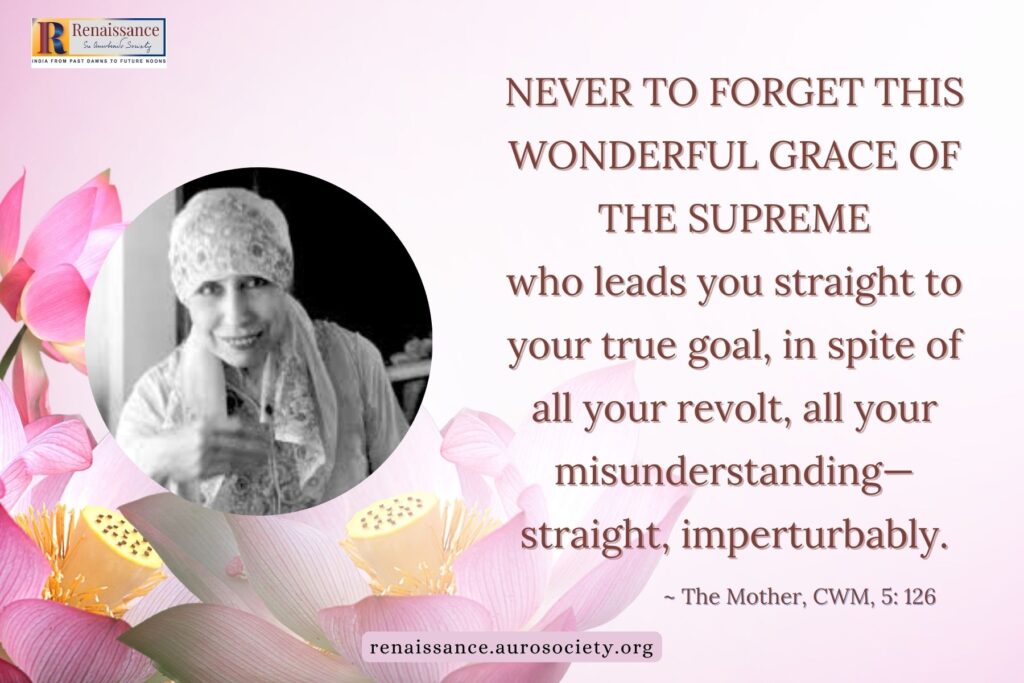As we continue with our year-long-theme of the Twelve Attributes of the Mother, we dedicate the present issue to Gratitude.
“To Thee Our Infinite Gratitude. . . ” The Mother’s words dated December 9th, 1950, which are engraved on the Samadhi at Sri Aurobindo Ashram are the most sublime, most perfect words to express our deepest Gratitude to Sri Aurobindo. We could not think of any other way to open this issue but with a sincere contemplation on these words:
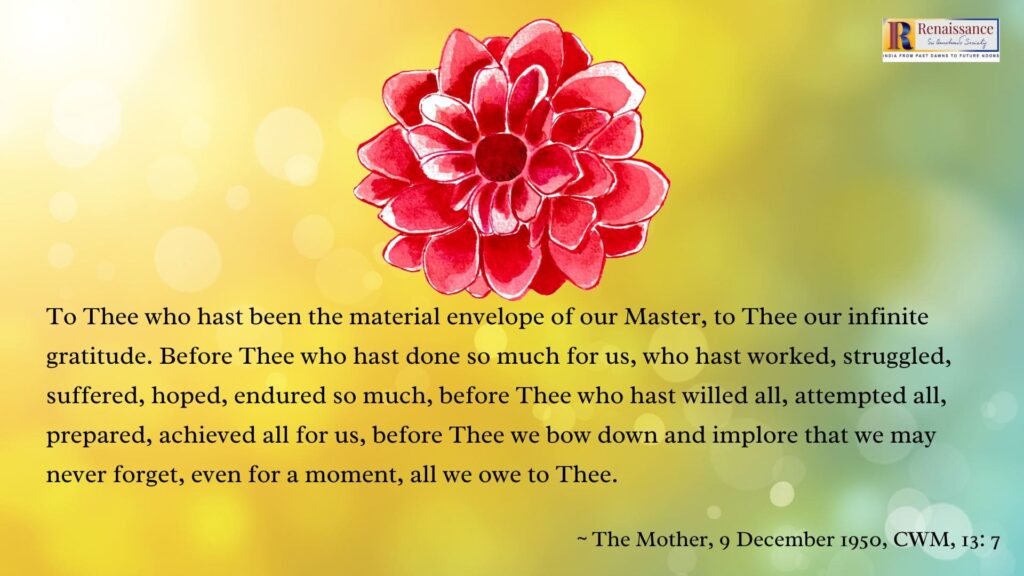
Some years back, while listening to a beautiful composition of Sant Tulsidās in the melodious voice of Pandit Jasraj, I became keenly aware of a remarkable and distinguishing aspect of the religio-spiritual culture of India – one of the many aspects which are unique to Sanātana Dharma, the foundation of all Indian spirituality. We have all seen and heard of devotees and faithful adoring, praising and glorifying the Lord. But in India alone we will find a bhakta-poet like Sant Tulsidās who has ‘seen’ and sung of his beloved Lord Sri Rāma praising his param-bhakta, his supreme devotee, Hanumān.
This bhajan, which opens with the line “भरत भाई! कपि से उरिन हम नाही. . . ,” brings in front of our eyes a remarkable scene in which Sri Rāma in a deeply moving manner tells his younger brother Bharat that he could never ever repay the debt he owes to Hanumān. As the bhajan continues, Sri Rāma recounts for his brother, one by one, some of the many great deeds Hanumān has done for him. He recalls how during the great battle with Rāvana and his army, Hanumān had saved Lakshmana’s life. Rāma is forever indebted to Hanumān, the Lord repeats.
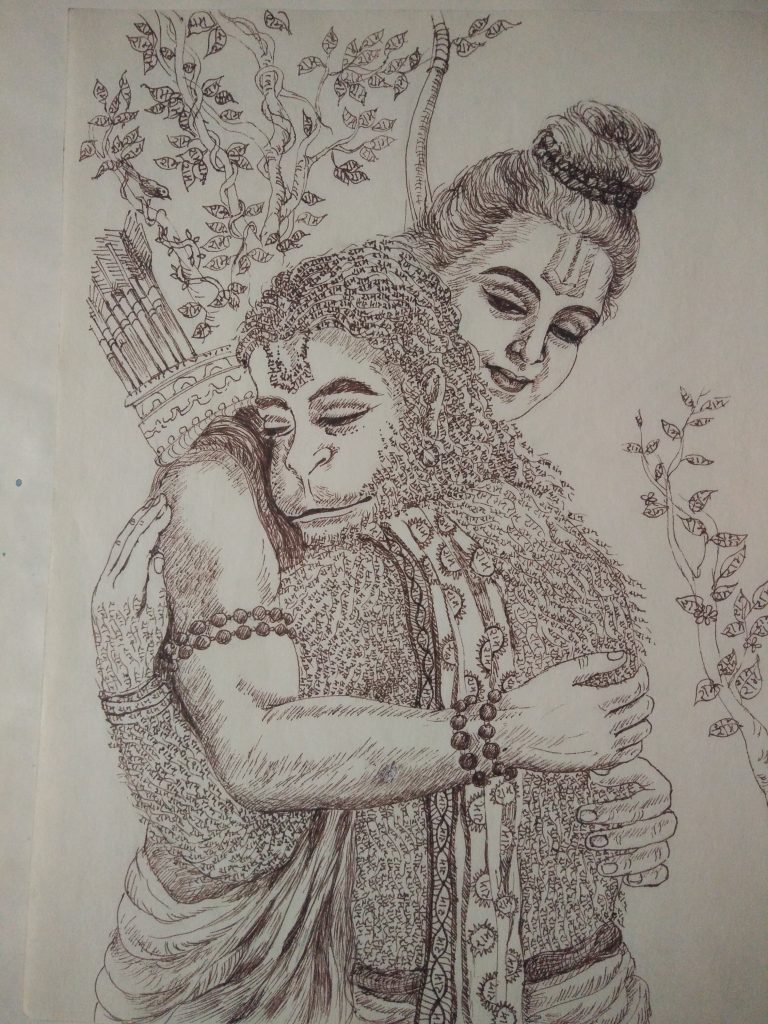
Such intense love of the Lord for his devotee, such adoration of the devotee by the Divine, this is only conceivable in this civilisation, this land where the Gods also long to be born. It is the deep spiritual core of our culture which makes a bhakta-kavi like Sant Tulsidās paint for us this picture of Sri Rāma, the Avatāra so fully expressing his life-long gratitude for his devotee.
After having just listened to the bhajan on my computer, now as I write about it, I find that the underlying feeling here is actually more, much more than gratitude. It is not about repaying Hanumān for all that he has done for Rāma, it is certainly not merely admiring or recognising him for his prowess.
There is a beautiful completeness of emotion here which comes only when devotion is accompanied by gratitude – whether it is devotion of Sri Rāma for Hanumān or that of Hanumān for Sri Rāma, which was why Hanumān constantly wished to serve his Lord in any and every way he could. Today it also reminds me of something the Mother once said, “devotion without gratitude is quite incomplete, gratitude must come with devotion.” (CWM, Vol. 8, p. 40)

In this age of instant gratification and instant nirvana, we have gratitude journals and gratitude jars – practices which could be perhaps helpful for some in initially cultivating a habit of remembering all that one must be grateful for – but often in this zeal to come up with and engage in outward practices, one may miss out on the deeper meaning and essence of gratitude, which, like compassion, the Mother reminds us, is a quality of the soul or the psychic entity within, not a mental formula.
As long as we are primarily led by the mind and vital, generally a distortion enters which converts the psychic movement of gratitude into a wish to repay; and over time it may change into the capacity to recognise and admire. The Mother explains that it is only when the psychic being within begins to take active part in our life, we begin to experience true gratitude for all that manifests the divine presence and grace, in whatever form. That is luminous gratitude in its purity, a source of unparalleled joy.

Tulsidās’ bhajan also speaks perfectly of the perfect nobility of Sri Rāma. As the Mother reminds – “The nobility of a being is measured by its capacity of gratitude.” (CWM, Vol. 14, p. 155). But it is not only through her words that She, the Supreme Mother, guides us. She embodies this nobility in her Being.
And we see a perfect example of that when we read her meditation dated March 3rd, 1914. This was the time when she was getting ready to leave for India. In this meditation, the Divine Mother is expressing her deep, intense and total gratitude for all the material objects that have served her.
As the day of departure draws near, I enter into a kind of self-communion; I turn with a fond solemnity towards all those thousand little nothings around us which have silently, for so many years, played their role of faithful friends; I thank them gratefully for all the charm they were able to give to the outer side of our life; I wish that if they are destined to pass into other hands than ours for any length of time, these hands may be gentle to them and know all the respect that is due to what Thy divine Love, O Lord, has brought out from the dark inconscience of chaos. . .
(The Mother, CWM, Vol. 1, p. 87)

This is how the Supreme Mother shows Her children the path of gratitude. Like Sri Rāma did earlier in Tulsidās’ bhajan.
She reminds us that we must develop in us a conscious sense of gratefulness toward all the objects, moments and experiences which have served us in any way, big or small, which have been our companions and guides of our progress. May we remember to be grateful because behind all it is the Divine Presence hiding and guiding.
It is only our limitation, our ego-self which prevents us from ‘seeing’ and ‘experiencing’ that divine presence in each and every creature, object, moment and experience. Cultivating a truly grateful heart can be a good practice to work on one’s ego.
For this issue’s Guiding Light section, we have selected passages from writings and conversations of the Mother which present a rich variety of the various hues of the soul-quality that is Gratitude: gratitude that helps us connect with the Divine; that is a humble recognition of all that the Divine has done and is doing for us; that helps us cure our egoism; gratitude as the movement that can bring us unalloyed joy. And most importantly, gratitude that is only a slightly coloured hue of the essential vibration of Love.
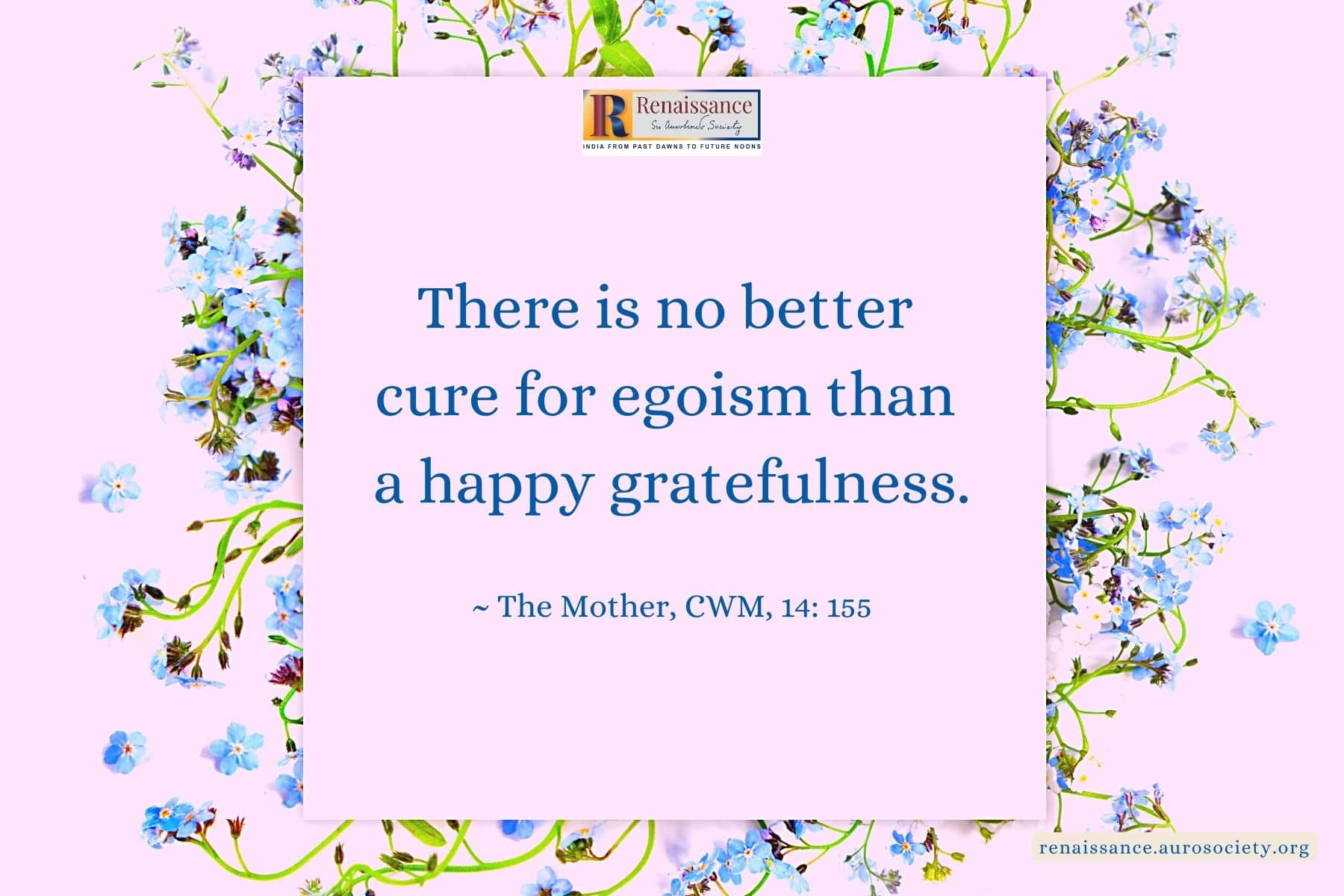
Highlighting the connection between Humility and Gratitude, the featured conversation of the Mother in the Sunlit Path section reminds us that in order to accept Divine’s Grace with a pure feeling of gratitude, one must have a certain inner humility which makes one recognise one’s helplessness without the Divine Grace. She also points out that for most people, blows in life are needed to know to the very depths that there is no entity without the Divine Consciousness and the Grace.
Sheeba Naaz, our regular contributor, brings for us a heartfelt meditation on the varied Colours of Gratitude. Reflecting on her own experience and a few other gratitude stories she has heard and witnessed around her, she reminds us that it is not really the happiness which makes us feel grateful but on the contrary it is gratefulness that makes us happy. The Mother’s ‘handkerchief’ story also finds a special place of honour in this beautiful piece.
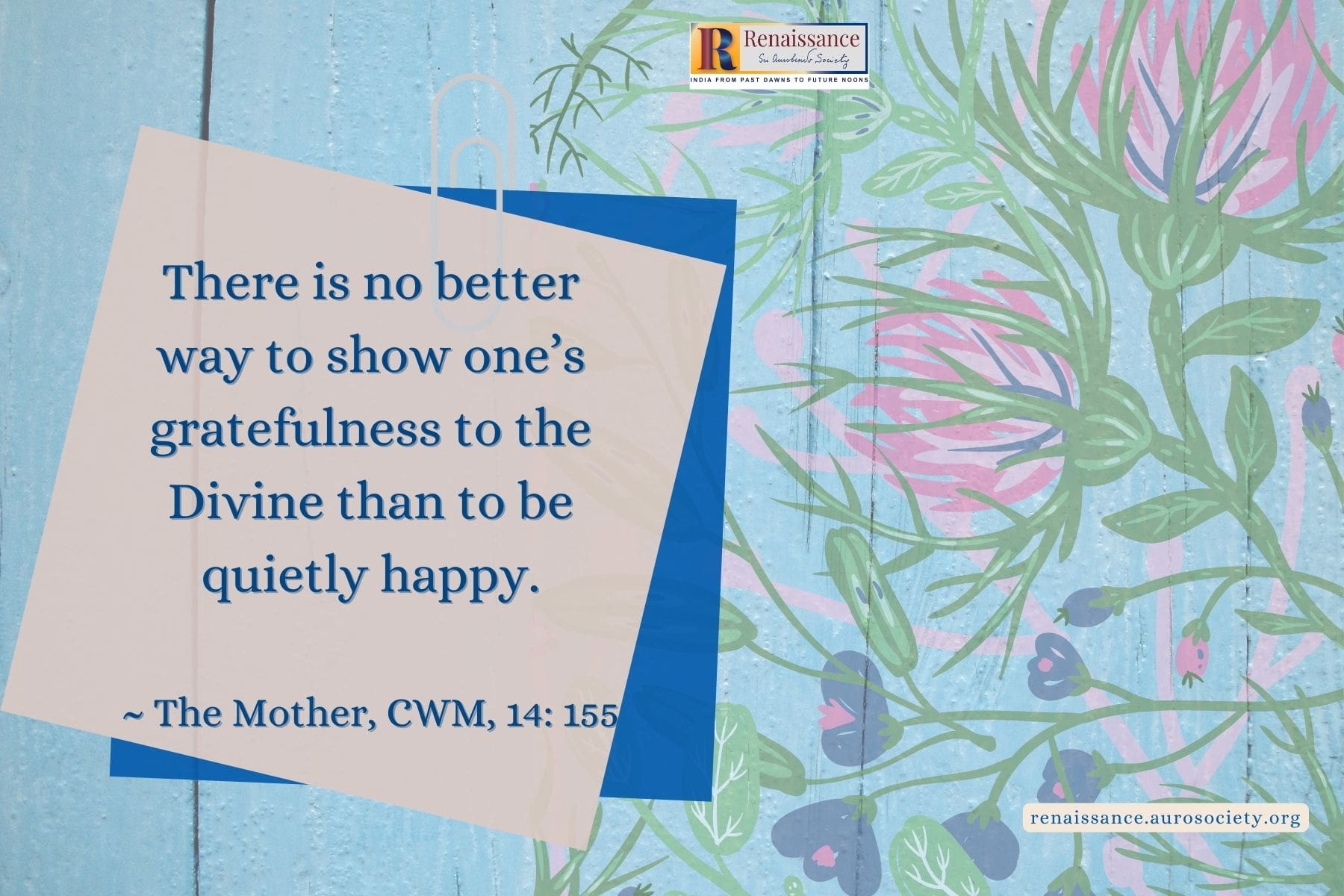
A small but equally beautiful reflection by Shiva Kumar, titled ‘I had a dream. . .‘ makes the reader feel grateful for witnessing through his words an experience of the Divine Friend whispering of Love and life as a means to seek that Love.
ALSO SEE:
Devotion without Gratitude is Incomplete
In our Tales and Stories section we bring two Gratitude related stories. One is a beautiful story told by the Mother, titled simply ‘The Virtues‘. Written by the Mother in French sometime between 1893 and 1912, this story helps us recognise how gratitude is generally the most neglected virtue.
The second is an interesting fable from the Panchatantra, which illustrates the spontaneous gratefulness of an animal often found missing in a human being.
In our Insightful Conversations we bring a fascinating conversation with a three-member team from Bengaluru-based Creative School. Inspired by the Integral Education teachings of the Mother and Sri Aurobindo and other spiritual masters who have guided the founding team, this institution is described by its members as a conscious community and holistic school for children, parents and teachers.
Watch our interview with the co-founders, Jayashree Ashok and B. Ashok, and the school principal Reshma Madhusudan in which they share about what inspires them and how they diligently and sincerely work to bring sacredness to their work as learners, teachers and mentors.
Navaratri and More
Indians all over the world recently celebrated the festivals of Durga Pujā, Vijayadashami and Navarātri, invoking Navadurga — nine forms of the Mother Goddess. In this month’s Special Features, we highlight an essay by Alok Pandey which presents some deep insights into the inner meaning of the festival of Devi and the work of the Divine Shakti.
Every year Durga Pujā is celebrated to mark the victory of the great Goddess Durga over the demon King Mahishāsura and his demon cohorts. Though outwardly it seems to be symbolic of the victory of Truth over falsehood, which it certainly is, the deeper symbolism of the festival helps us understand the process of individual and cosmic evolution. This 3-part-essay explores the inner significance of this festival.
Our second offering for the festival of the Divine Shakti ‘The Mother Indeed is Always Present‘ carries this theme of inner significance further. It features two excerpts from M. P. Pandit’s book titled, Commentaries on the Mother’s Ministry, Vol. 1 (1983), published by Sri Aurobindo Ashram.
Reading these passages gently reminds us that for all those who have turned to Her, meditating on who the Mother is, opening oneself to Her Force, giving oneself to Her entirely so that She may make of us what She wills – this is truly the pujā to be offered at Her Lotus Feet.
Also see our Navarātri Special Flipbooks:
Navadurga – The Nine Forms of the Goddess
&
Open Your Soul to Her
Every year Mother Durgā comes to slay the asura, and the asura rises again creating another havoc, another turmoil. This is true for the individual and for the nation. While there is an important spiritual and occult truth behind this ongoing battle between Truth and Falsehood – truth that goes back to the beginning of all creation or manifestation, – the Mother helps us understand one more psychological-spiritual truth as to why it continues.
“You know the story of Durga, don’t you? Durga who every year has to destroy her asura; and always she is compelled to begin again. It goes on in this way till the end of the reign allotted to the titans. When they will be banished from this world, it will not be thus any longer.
But till then, that is as long as they are useful. . . for intensifying the aspiration, clarifying the consciousness, for putting to the test the sincerity of people, they will be there. The day the test will not be needed, the day the sincerity will be pure and self-existent they will disappear. Then that day, Durga will no longer need to begin her battle over again every year.”
(CWM, Vol. 5, pp. 96-97)
An honest look at the world within and around us will tell us that the humanity is nowhere near the point when it is no longer necessary for Mā Durgā to continue her battle against the asura. Many more turmoils are yet in store for the humanity, because we haven’t yet learned to completely surrender to the Divine Power, the Divine Shakti which creates, executes and rules over all. We run after the little powers that are all rooted in individual or collective egos and fail to see the work of Divine Providence behind the outer phenomena. So the Mother comes again, to remind us, to wake us from our slumber.
Because humanity was not ready to receive the Complete Force of Divine Mother, in an earlier age Mother Sitā had to be banished by Sri Rāma, sent to live in a hermitage away from the crude mentality of the ordinary public which was (and is) closed to higher Truth. Mā Sita, an embodiment of Divine Mother and a daughter of Mother Earth had to conceal herself back in the Earth, and wait till Her children are ready for all Her Power and Force. Sitā’s banishment, as depicted in Kālidāsa’s Raghuvamśam is the subject in our Book of the Month feature.
Dussehra or Vijayadashami marks another important event in India’s religio-spiritual history, one that has deeply impacted the cultural mind of India. The decisive victory of the divine man Rāma over the Rākshasa Rāvana is a reminder that the anarchic, vitalistic-animalistic temperament which is excessive, dominating and violently egoistic, must eventually lose to a temperament that is harmonising, sāttvic and gentle.
This is the essence of the story of the Ramayana, a work which Sri Aurobindo says has had an incalculable power in moulding the cultural mind of India. We present two features which speak of the significance of the Ramayana in the light of Sri Aurobindo — a short video lecture on the theme The Rāmāyana and the Cultural Mind of India and an article titled Rām-kathā, a Living Tradition of India.
Earlier this month India celebrated Gandhi Jayanti. In this India’s 75th year of political independence, it is timely to re-assess Gandhiji’s role in India’s freedom movement. Given that our national mind now seems ready to evaluate and understand the role played by some of the leading personalities in shaping the post-Independence India, revisiting this article ‘The Real Gandhi‘ written by Amal Kiran in 1949, which has the approval of Sri Aurobindo, is highly necessary and relevant today.
The current issue also features part 5 of the series, सर्वे सन्तु निरामयाः – May All be Free from Illness, where the author, Rajeshwari, reminds us that considerable knowledge and understanding of subtle truths of natural laws was behind many of the hygiene related practices and modes of conduct which we hear from our elders. Indeed, we are grateful for such practical wisdom we have inherited from our ancestors, and also to those who have carefully preserved it.
Also featured is part 4 of the ongoing series, Sri Aurobindo on Isha Upanishad, where M.P. Pandit brings us now to a contemplation on verses 9-14. Meditating on these verses brings a spontaneous feeling of gratitude toward our Rishis, of yore and of our times. They have given us such profound truths of Existence and Life, Spirit and Matter, and have also shown us the path of Truth to walk on, so that one day this earthly life be transformed into a Divine Life.
* * *
There is no better way to close this editorial than by consciously bringing to our awareness that only when we can begin to live in our inmost being, the psychic entity within, we begin to live in a constant, complete and true gratitude.
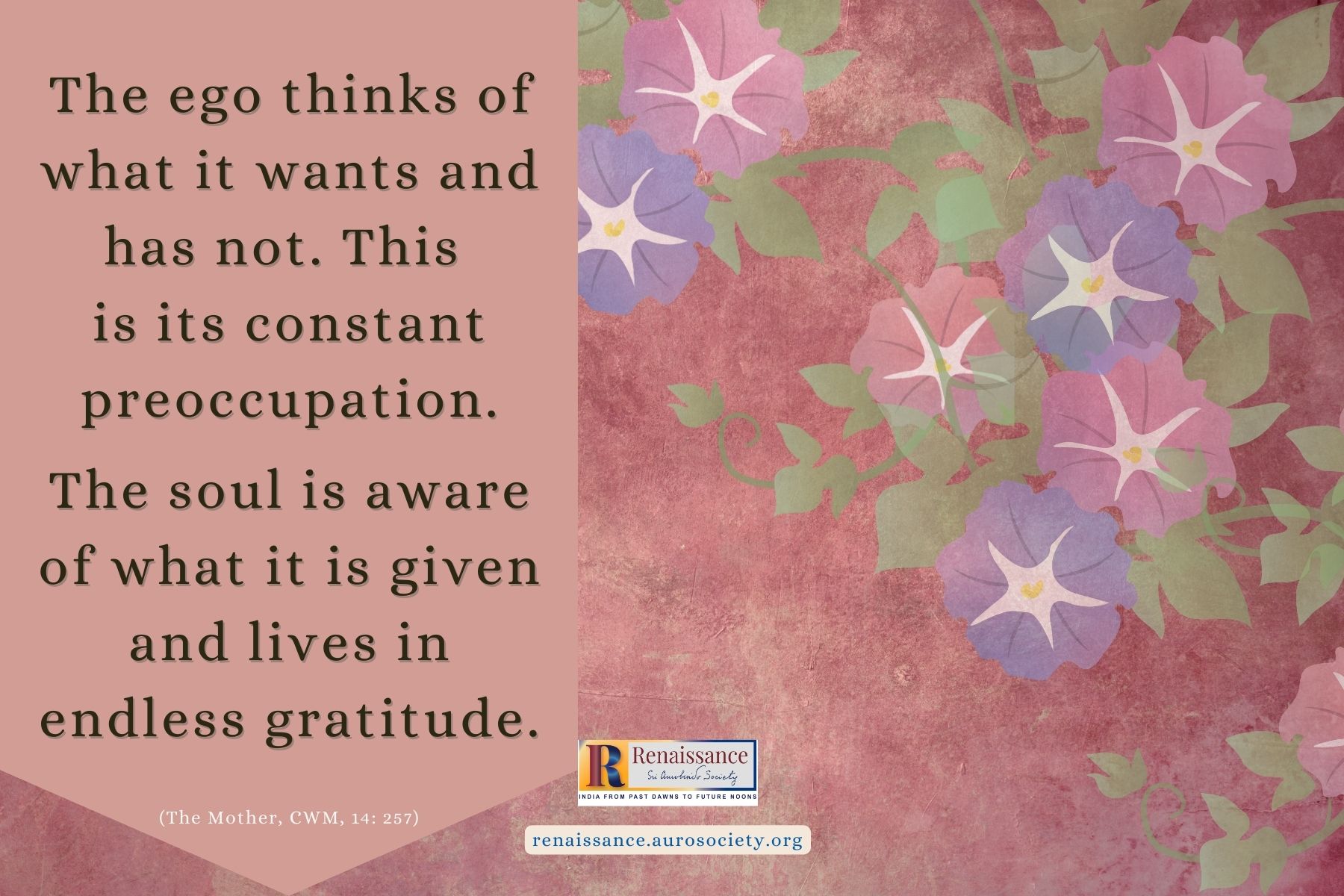
I hope our readers will find value and inspiration in this issue’s wide range of offerings. With a prayerful heart and with humble gratitude toward the Divine, I offer this work at the lotus feet of Sri Aurobindo and the Mother.
In gratitude,
Beloo Mehra (for Renaissance Editorial Team)

~ Design: Beloo Mehra

